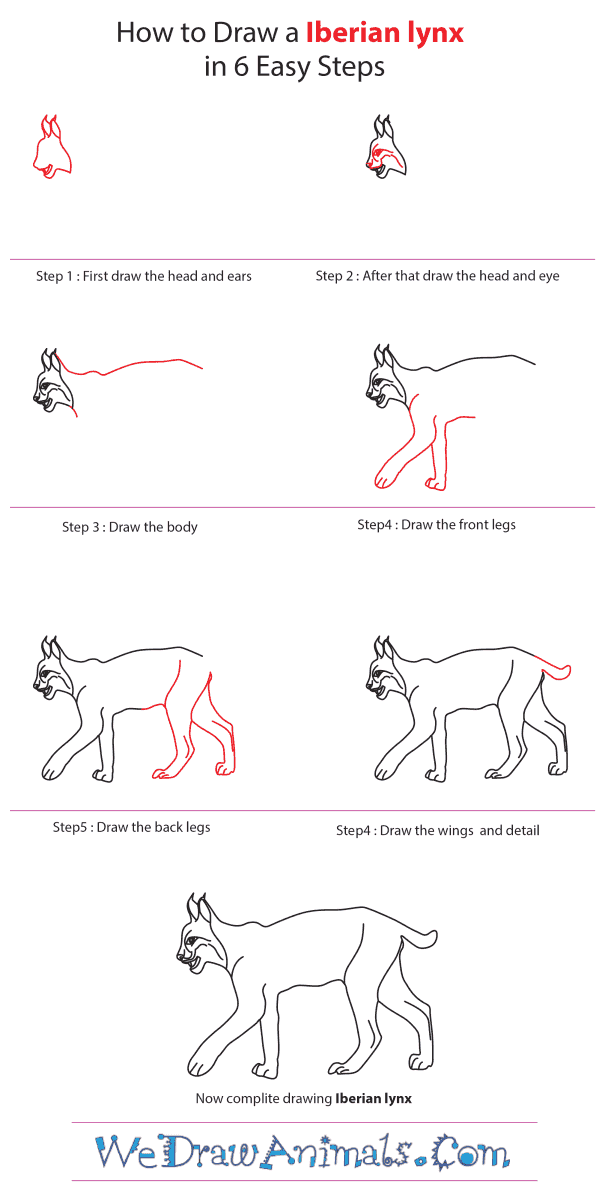In this quick tutorial you'll learn how to draw an Iberian Lynx in 6 easy steps - great for kids and novice artists.
The images above represent how your finished drawing is going to look and the steps involved.
Below are the individual steps - you can click on each one for a High Resolution printable PDF version.
At the bottom you can read some interesting facts about the Iberian Lynx.
Make sure you also check out any of the hundreds of drawing tutorials grouped by category.
How to Draw an Iberian Lynx - Step-by-Step Tutorial
Step 1: Let us start by drawing the outline of the Iberian Lynx's head, mouth and ears. Start by drawing two leaf shapes, side-by-side, for the ears. Draw a gently curved line to show the face and nose of the Iberian Lynx. Use U-shaped lines to show the open mouth of the animal. Starting at the right ear, draw a gently curved line to show the neck of the lynx.
Step 2: Next, draw small lines to show the nose of the lynx and fill it in. Draw a small oval for the eye and fill it in. Draw small, gently curved lines around the eye to show the forehead, sides of the nose, cheeks and face details of the Iberian Lynx
Step 3: Draw a small line below the head to show the neck of the lynx. Use a wavy line to draw the back of the Iberian Lynx as shown in the image.
Step 4: For the first fore leg, draw two S- shaped lines and join them at the end in a curve. Draw two small curved lines to show the paws of the Iberian Lynx. Then, draw the other fore leg behind the first one using a slanting line and a curved line. End the leg in a curve and add the paw details using small curved lines.
Step 5: Next, let us draw the hind legs of the Iberian Lynx using S- shaped lines. Leave a small blank space for the tail between the top of the hind legs and the back. Draw the paw details for both legs using small curved lines as shown in the image. Draw two backwards L-shaped lines to show the muscle details of the lynx's hind legs. Continue the line from the fore legs and join it to the hind legs to show the belly of the Iberian Lynx.
Step 6: Draw the short tail of the Iberian Lynx using two curved lines and join it together in a curve. Now that your drawing of the Iberian Lynx is complete, you can color it.
Interesting Facts about the Iberian lynx (Lynx pardinus):
The Iberian lynx lives in the Mediterranean region of southern Spain. Spain is on the Iberian Peninsula, hence the name of this species of lynx. The Iberian lynx has black tufts on its ears, and a long “beard” under its chin. The Iberian lynx, like other species of lynx, has long legs and a short tail. They are beautifully spotted and their coat is a tawny color to blend in with their habitat. They are about two feet tall and three feet long, and can weigh between twenty and sixty pounds, with males much heavier than females.
Did you know?
- An Iberian lynx’s favorite food is rabbit. If rabbit populations go down, it can drastically affect the population of the Iberian lynx because they eat almost nothing else.
- Two of the biggest threats to the Iberian lynx are habitat loss and getting hit by cars.
- There may be fewer than one hundred Iberian lynx left in the wild.
- Two hundred years ago, the Iberian lynx lived in Spain, Portugal and the south of France. Today it is only found in a very small area of southern Spain.
- There are about eighty Iberian lynx being raised in a captive breeding program to try to keep the species from going extinct.
The Iberian lynx is the most endangered species of wild cat in the world. In fact, it is considered “critically endangered.” If the Iberian lynx were to become extinct, it would be the first time a feline species has disappeared from the planet since prehistoric times. It is a beautiful, rare and majestic animal. There are many organizations working hard to try to keep the Iberian lynx from going extinct.







